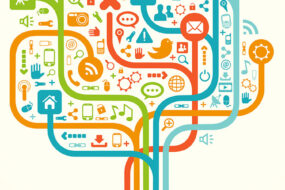
In recent years, wearable technology has evolved from simple gadgets into essential tools that enhance our daily lives. From fitness trackers and smartwatches to health monitors and augmented reality glasses, wearable tech is revolutionizing how we manage our health, improve productivity, and interact with the world around us. In this article, we’ll explore the latest innovations in wearable devices, their impact on personal well-being, and how they are shaping the future of technology.
1. Smartwatches: More Than Just Timekeepers
Smartwatches, such as the Apple Watch, Samsung Galaxy Watch, and Fitbit, have become the centerpiece of wearable technology. These devices offer far more than just timekeeping; they function as personal assistants, health monitors, and fitness trackers all in one.
Key Features of Modern Smartwatches:
- Health and Fitness Tracking: Smartwatches can track a variety of health metrics, such as heart rate, steps taken, calories burned, and even blood oxygen levels. Many models now include advanced features like ECG (electrocardiogram) monitoring, sleep tracking, and stress management.
- Real-Time Notifications: Smartwatches sync with your phone to display messages, emails, calendar events, and app notifications, all without needing to reach for your phone. This improves convenience and helps you stay organized.
- Fitness Coaching: With built-in fitness apps, smartwatches can guide you through workouts, track your progress, and offer personalized recommendations based on your fitness level and goals.
- Integration with Health Services: Some models allow users to share health data directly with healthcare providers, making it easier for doctors to monitor conditions remotely.
Real-World Example:
- Apple Watch Series 9: The latest model of the Apple Watch offers a new Always-On display, more accurate health sensors for tracking blood oxygen and heart rate, and sleep stage monitoring. It also features fall detection and ECG capabilities, providing critical health insights.
2. Fitness Trackers: Dedicated Health and Fitness Monitoring
Fitness trackers have long been popular for those looking to monitor their daily activity levels. While they may not have all the features of smartwatches, they offer specialized insights into health and fitness, making them ideal for users who prioritize activity tracking and personal well-being.
Key Features of Fitness Trackers:
- Step and Activity Tracking: Fitness trackers like Fitbit Charge 5 and Garmin Vivosmart 5 are known for their ability to accurately monitor steps, distance traveled, and active minutes throughout the day.
- Heart Rate and Sleep Monitoring: Advanced models include continuous heart rate monitoring and sleep tracking, which help users understand their fitness and recovery patterns.
- Battery Life: Fitness trackers often offer extended battery life compared to smartwatches, with some models lasting up to a week on a single charge, making them a practical option for long-term health tracking.
- Stress and Recovery Insights: Some fitness trackers include features to measure stress levels, body battery (energy levels throughout the day), and offer suggestions for recovery, promoting overall well-being.
Real-World Example:
- Fitbit Charge 5: The Charge 5 offers ECG monitoring, stress management tools, daily readiness scores, and sleep tracking. It’s designed for people focused on improving physical and mental health through data-driven insights.
3. Smart Glasses: Augmenting Reality and Connectivity
Smart glasses have gained attention in recent years, blending technology with everyday life in a sleek and unobtrusive form. Companies like Google, Ray-Ban, and Snapchat have introduced smart glasses with augmented reality (AR) features, enabling users to interact with the digital world in a new and exciting way.
Key Features of Smart Glasses:
- Augmented Reality (AR): AR-enabled glasses like the Microsoft HoloLens or Google Glass display information directly onto the lens, offering an immersive experience that integrates digital data with the physical world. This technology is used in a variety of applications, including navigation, education, and remote collaboration.
- Hands-Free Communication: Smart glasses equipped with voice assistants or Bluetooth connectivity enable hands-free calls, text messages, and notifications, allowing users to stay connected without taking their phone out of their pocket.
- Fitness and Health Monitoring: Some smart glasses include built-in health monitoring sensors, such as heart rate tracking, eye strain detection, or posture correction, helping users improve their physical well-being.
Real-World Example:
- Ray-Ban Stories: In collaboration with Facebook (now Meta), Ray-Ban has launched Ray-Ban Stories, which are smart glasses with built-in speakers and cameras. They allow users to make hands-free calls, listen to music, and capture photos or videos, all while looking like regular sunglasses.
4. Wearable Health Monitors: The Next Frontier in Personal Health
One of the most exciting areas of wearable tech is the rise of advanced health monitors that go beyond the basics of fitness tracking. These devices are designed to give individuals greater control over their health and provide valuable insights into chronic conditions, fitness levels, and overall wellness.
Key Innovations in Health Monitoring:
- Continuous Glucose Monitors (CGMs): Wearable CGMs like the Dexcom G6 offer real-time glucose level monitoring for people with diabetes, allowing them to better manage their condition and make adjustments to their diet and insulin levels.
- Blood Pressure Monitors: Devices like the Omron HeartGuide combine the functionality of a smartwatch with the ability to take accurate blood pressure readings, helping users stay on top of their heart health.
- Mental Health and Stress Monitoring: Wearables are increasingly incorporating mental health tracking features, such as mood monitoring, stress detection, and even biofeedback techniques, to help users manage anxiety and improve emotional well-being.
- Sleep and Breathing Monitors: Wearables like the Oura Ring and Whoop Strap focus on sleep tracking and recovery, offering detailed data on sleep cycles, respiratory rate, and HRV (heart rate variability), crucial for understanding your overall health.
Real-World Example:
- Oura Ring: This sleek, minimalistic device focuses on sleep quality, activity, and overall wellness. It tracks metrics such as body temperature, heart rate, sleep stages, and activity levels to provide personalized insights into physical and mental recovery.
5. Wearable ECG Monitors: Keeping Heart Health in Check
For individuals concerned about heart health, wearable ECG monitors provide an easy and accessible way to keep track of heart activity. These devices are especially important for those with heart conditions or those looking to prevent potential issues.
Key Features of ECG Monitors:
- Electrocardiogram (ECG): Many wearables, including the Apple Watch and Withings Move ECG, now feature built-in ECG monitors, allowing users to perform heart health assessments anywhere, anytime.
- Arrhythmia Detection: Some devices can detect irregular heart rhythms, providing users with early warnings for conditions like atrial fibrillation (AFib), a common cause of stroke.
- Data Sharing with Healthcare Providers: Some wearables enable users to send their ECG readings directly to healthcare providers for further analysis and treatment recommendations.
Real-World Example:
- Apple Watch Series 9: This smartwatch includes a built-in ECG app that allows users to record an electrocardiogram in just 30 seconds, providing detailed heart health insights and notifying them of potential irregularities.
6. Smart Clothing: The Future of Wearable Tech
Smart clothing is an emerging category in wearable technology, where the fabric itself is embedded with sensors to track vital health information. These garments can measure heart rate, body temperature, and even muscle activity, offering users an unprecedented level of real-time health monitoring.
Key Features of Smart Clothing:
- Smart Shirts and T-shirts: Garments like the Hexoskin Smart Shirt and Athos track heart rate, breathing, and muscle effort during physical activity. These clothes can provide valuable feedback to athletes and fitness enthusiasts, optimizing performance and recovery.
- Wearable Thermoregulation: Some smart clothing features temperature-regulating technology, allowing users to stay comfortable in varying weather conditions by automatically adjusting to body temperature.
- Smart Socks and Insoles: Some brands offer smart socks and insoles that measure foot pressure and gait, which can be useful for athletes or individuals with foot-related health issues like plantar fasciitis.
Real-World Example:
- Hexoskin Smart Shirt: This shirt uses sensors woven into the fabric to measure heart rate, breathing, and movement, providing real-time data on your physical performance. It’s popular among athletes and those with chronic health conditions.
Conclusion: The Future of Wearable Tech
The world of wearable technology is evolving rapidly, offering innovations that empower individuals to take charge of their health and well-being in ways that were once unimaginable. Whether it’s a smartwatch that tracks your fitness, smart glasses that enhance connectivity, or health monitors that provide real-time insights into your body’s performance, wearable tech is making it easier than ever to live a healthier, more efficient life. As these devices continue to evolve and integrate more advanced features, we can expect wearable tech to play an increasingly vital role in improving our quality of life in 2024 and beyond.








